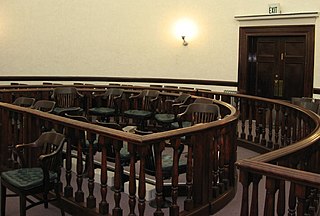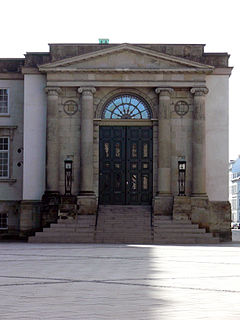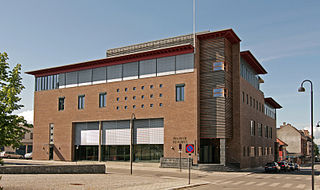
A jury trial, or trial by jury, is a lawful proceeding in which a jury makes a decision or findings of fact. It is distinguished from a bench trial in which a judge or panel of judges makes all decisions.

A jury is a sworn body of people (jurors) convened to render an impartial verdict officially submitted to them by a court, or to set a penalty or judgment. Juries developed in England during the Middle Ages and are a hallmark of the Anglo common law legal system. They are still commonly used today in the United Kingdom, the United States, Canada, Ireland, Australia, and other countries whose legal systems are descended from English and later British legal traditions.
In Norway, the district court is the first court instance, and handles both criminal and civil cases. The chief judge of a district court is the chief district judge.

The Courts of Denmark is the ordinary court system of the Kingdom of Denmark. The Courts of Denmark as an organizational entity was created with the Police and Judiciary Reform Act taking effect 1 January 2007 which also significantly reformed the court system e.g. by removing original jurisdiction from the High Courts and by introducing a new jury system.

The Supreme Court of Norway was established in 1815 on the basis of section 88 in the Constitution of the Kingdom of Norway, which prescribes an independent judiciary. It is located in the capital Oslo. In addition to serving as the court of final appeal for civil and criminal cases, it can also rule whether the Cabinet has acted in accordance with Norwegian law and whether the Parliament has passed legislation consistent with the Constitution.

Under the Constitution of Finland, everyone is entitled to have their case heard by a court or an authority appropriately and without undue delay. This is achieved through the judicial system of Finland.

The Judiciary of Russia interprets and applies the law of Russia. It is defined under the Constitution and law with a hierarchical structure with the Constitutional Court and Supreme Court at the apex. The district courts are the primary criminal trial courts, and the regional courts are the primary appellate courts. The judiciary is governed by the All-Russian Congress of Judges and its Council of Judges, and its management is aided by the Judicial Department of the Supreme Court, the Judicial Qualification Collegia, and the Ministry of Justice, and the various courts' chairpersons. And although there are many officers of the court, including jurors, the Prosecutor General remains the most powerful component of the Russian judicial system.

The Gulating Court of Appeal is one of six courts of appeal in the Kingdom of Norway. The Court is located in the city of Bergen. The court has jurisdiction over the counties of Vestland and Rogaland plus Sirdal Municipality in Agder county. These areas constitute the Gulating judicial district. This court can rule on both civil and criminal cases that are appealed from one of its subordinate district courts. Court decisions can be, to a limited extent, appealed to the Supreme Court of Norway. There are 33 permanent judges seated on this court. The chief judicial officer of the court is currently Magni Elsheim. The court is administered by the Norwegian National Courts Administration.

The judicial reform of Alexander II is generally considered one of the most successful and consistent of all his reforms. A completely new court system and order of legal proceedings were established. The main results were the introduction of a unified judicial system instead of a cumbersome set of estates of the realm courts, and fundamental changes in criminal trials. The latter included the establishment of the principle of equality of the parties involved, the introduction of public hearings, the jury trial, and a professional advocate that had never existed in Russia. However, there were also problems, as certain obsolete institutions were not covered by the reform. Also, the reform was hindered by extrajudicial punishment, introduced on a widespread scale during the reigns of his successors – Alexander III and Nicholas II.
In some jurisdictions, an assessor is a judge's or magistrate's assistant. This is the historical meaning of this word.
The Appeals Selection Committee of the Supreme Court was originally a court of Norway in its own right, however, it does not anymore constitute an instance – a case will be decided upon either by the Appeals Selection Committee or by the Supreme Court. The Appeals Selection Committee intermittently comprises three Supreme Court Justices appointed by the Chief Justice of the Supreme Court of Norway.

The judiciary of Austria is the system of courts, prosecution and correction of the Republic of Austria as well as the branch of government responsible for upholding the rule of law and administering justice. The judiciary is independent of the other two branches of government and is committed to guaranteeing fair trials and equality before the law. It has broad and effective powers of judicial review.
The court of appeal is the second level of courts of justice in Norway, reviewing criminal and civil cases appealed from the district courts. There are six courts of appeal, each covering a jurisdiction and based in a city. Each court is led by a senior judge president (førstelagmann) and several appellate judges (lagdommer). The courts are administrated by the Norwegian National Courts Administration. Decisions from civil and criminal matters, except the question of guilt, can be appealed from the courts of appeal to the Supreme Court.

The Supreme Court is the supreme court and the third and final instance in all civil and criminal cases in the Kingdom of Denmark. It is based at Christiansborg Palace in Copenhagen which also houses the Danish Parliament and the Prime Minister's office.

The judicial system of Sweden consists of the law of Sweden and a number of government agencies tasked with upholding security and rule of law within the country. The activities of these agencies include police and law enforcement, prosecution, courts, and prisons and other correctional services.

Hedmarken District Court was a district court in Innlandet county, Norway. The court existed from 1588 to 1777 and again from 1992 until 2021. It served the Hedmarken area which included the municipalities of Hamar, Løten, Ringsaker, and Stange. The court was based in Hamar. The court had one chief judge, four other judges and two deputy judges, as well as an administrative staff of 12. Cases from this court could be appealed to the Eidsivating Court of Appeal in Hamar.
A lay judge, sometimes called a lay assessor, is a person assisting a judge in a trial. Lay judges are used in some civil law jurisdictions. Lay judges are appointed volunteers and often require some legal instruction. However, they are not permanent officers. They attend proceedings about once a month, and often receive only nominal or "costs covered" pay. Lay judges are usually used when the country does not have juries. Lay judges may be randomly selected for a single trial, or politically appointed. In the latter case they may usually not be rejected by the prosecution, the defense, or the permanent judges. Lay judges are similar to magistrates of England and Wales, but magistrates sit about twice as often.

The judiciary of Belgium is similar to the French judiciary. Belgium evolved from a unitary to a federal state, but its judicial system has not been adapted to a federal system.

The Judiciary of the Netherlands is the system of courts which interprets and applies the law in the Netherlands.
Sogn og Fjordane District Court is a district court located in Vestland county, Norway. This court is based at two different courthouses which are located in Førde and Sogndalsfjøra. There is also a courthouse in Nordfjordeid, however, this courthouse is not staffed, but it can be used by the court if needed. The court serves the northern part of the county which includes 18 municipalities. The court in Førde accepts cases from the municipalities of Askvoll, Bremanger, Fjaler, Gloppen, Gulen, Hyllestad, Høyanger, Kinn, Solund, Stad, Stryn, and Sunnfjord. The court in Sogndalsfjøra accepts cases from the municipalities of Aurland, Luster, Lærdal, Sogndal, Vik, and Årdal. The court is subordinate to the Gulating Court of Appeal.


















